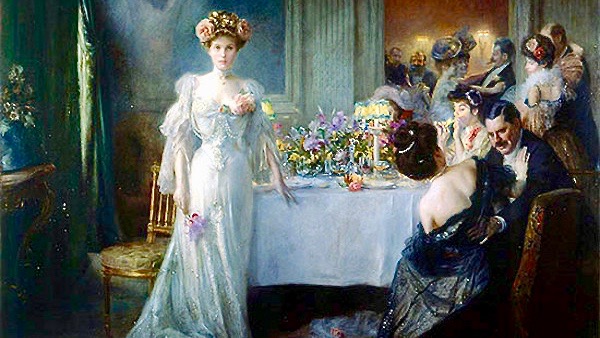I was asked recently, “Why do a blog about old etiquette? No one’s going to change the way they act.” That’s probably true and that’s ok. I love the minutia of historical etiquette, but it is rather like looking at a wonderful piece of very stuffy old art. While it might delight me in a museum, I wouldn’t necessarily want to live with it in my home. I would enjoy visiting historical etiquette for a weekend, but living my everyday life by the strictures of proper etiquette would be torture.
For a while, I was a member of a group of friends that would recreate old menus. We each took on a dish pot luck style, and then served them as close as possible to the manner that they would have been served in history. It was great fun until a few members became rigid about how everyone should behave, dress and act during the dinners. Some people also became quite competitive about how perfectly they made a dish or how accurately they prepared it. A few rules which make a group have cohesion are wonderful, too many and you alienate the very people you want to include.
When you find yourself with someone imposing very rigid etiquette rules or tusk-tusking about finger bowls or colorful candles, it’s says more about their insecurities than anyone else’s manners.
That said, if you accept an invitation to a formal event, you’re expected to know and to follow the rules. If you don’t like rules, skip the event. When someone goes to a lot of trouble to visit old manners, you don’t need to be the party pooper for everyone else.
I do cover modern manners, but with an eye to the fact that rarely are etiquette rules a given. We forget that manners aren’t just country specific, but regional as well. Etiquette can change radically from one town to another. What you might consider stuffy may be lax to others. One doesn’t have to change ones self entirely for another culture, but it’s not too much to ask to not wear a speedo to someone else’s church, even if you’re allowed to back home.
The snob’s opinion will differ on this. I know people who honestly believe that if the old rules aren’t followed, the world will slide into incivility and become intolerable. Part of me understands where they’re coming from, but all you have to do is read the comment section of Twitter or YouTube to realize that civility is in scare attendance already. The question becomes, where do you draw the line? Are we going to return to the time when women weren’t allowed to cross the room to speak with a man? Modern women aren’t going to tolerate that. Knowing what people used to do and why, we can each make informed decisions as to which rules we want to keep now.
That is also why I will never tell you that there is one “correct” way to act. I quite honestly loathe experts who tell you there is a “right” or “wrong” way to behave based solely on tradition or their own local customs. I believe these people are one of the reasons manners have declined so deleteriously. No one wants some prig telling them that they have to adhere to hundred year old rules, just because. Manners will only be taken up en masse when they are based on what is kind, civil and acceptable where one lives.
Behaving as if you live in Buckingham palace when you live in a condo in Bellingham, WA is not for most people. If it’s your jam, go right ahead, just don’t expect anyone else to follow suit. When it comes to manners, you want to be gloriously yourself, not Hyacinth Bucket.
By illuminating historical etiquette, I’m hoping that we all have a little fun and possibly advocate for a general level of niceness towards everyone. So, as we move forward, I hope you’ll be thinking about the rules that you think are absolute necessities and those which are just fun to know. I also hope you know that when I say I like something a certain way, that is only my opinion, yours is equally valid.
Much Love and Stay Safe,
Cheri



